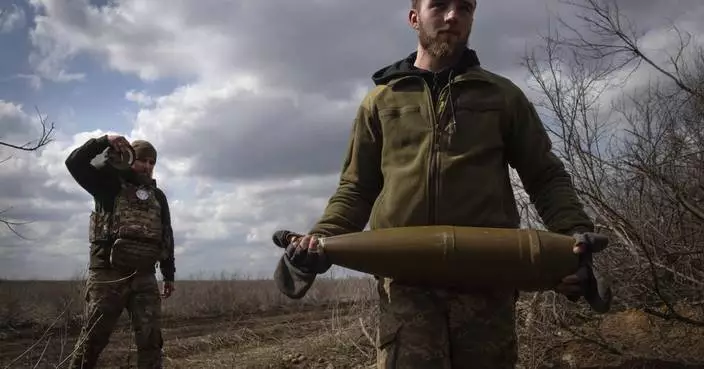Alaska has been America's canary in the coal mine for climate warming, and the yellow bird is swooning.
July was Alaska's warmest month ever, according to the National Oceanic and Atmospheric Administration.
Sea ice melted. Bering Sea fish swam in above-normal temperatures. So did children in the coastal town of Nome. Wildfire season started early and stayed late. Thousands of walruses thronged to shore.

Central Florida resident Paul Leake photographs a dahlia garden in Town Square in Anchorage, Alaska, Thursday, Aug. 15, 2019. Alaska recorded its warmest month ever in July and hot, dry weather has continued in Anchorage and much of the region south of the Alaska Range. (AP PhotoDan Joling)
Unusual weather events like this could become more common with climate warming, said Brian Brettschneider, an associate climate researcher at the University of Alaska Fairbanks' International Arctic Research Center. Alaska has seen "multiple decades-long increases" in temperature, he said.
"It becomes easier to have these unusual sets of conditions that now lead to records," Brettschneider said.
Alaska's average temperature in July was 58.1 degrees (14.5 Celsius). That's 5.4 degrees (3 Celsius) above average and 0.8 degrees (0.4 Celsius) higher than the previous warmest month of July 2004, NOAA said.

Denise Armitage of Toowoomba, Queensland, Australia, photographs dahlias at gardens in Town Square in Anchorage, Alaska, Thursday, Aug. 15, 2019. Alaska recorded its warmest month ever in July and hot, dry weather has continued in Anchorage and much of the region south of the Alaska Range. (AP PhotoDan Joling)
The effects were felt from the Arctic Ocean to the world's largest temperate rainforest on Alaska's Panhandle.
Anchorage, the state's largest city, on July 4 for the first time hit 90 degrees (32.22 Celsius) at Ted Stevens Anchorage International Airport, 5 degrees higher than the city's previous recorded high of 85 degrees (29.44 Celsius).
Sea ice off Alaska's north and northwest shore and other Arctic regions retreated to the lowest level ever recorded for July, according to the National Snow and Ice Data Center at the University of Colorado.
Arctic sea ice for July set a record low of 2.9 million square miles (7.6 million square kilometers). That was a South Carolina-size loss of 30,900 square miles (80,000 square kilometers) below the previous record low July in 2012.
Sea ice is the main habitat for polar bears and a resting platform for female walruses and their young. Several thousand walruses came to shore July 30, the first time they've been spotted in such large numbers before August.
Effects were less obvious in the Bering Sea off Alaska's west coast. Lyle Britt, a NOAA Fisheries biologist who oversees the agency's annual Bering Sea groundfish survey, was on a trawler east of the island of Saint Matthew during the first week of July.
"The temperature out there for us was in the high 70s," Britt said. "On those boats, everything up there is designed to conserve heat, not vent heat. It was unbearably warm inside the boat."
On the ocean bottom, Britt's crew for the second consecutive year found scant evidence of a "cold pool," the east-west barrier of extremely cold, salty water that traditionally concentrates Pacific cod and walleye pollock, the species that make fast-food fish sandwiches, in the southeastern Bering Sea.
Alaska's wildfire season started in April. July's dry and hot temperatures extended it. An expected rainy season marked by southwest winds pushing up moisture and soaking fires did not show up on time, said Tim Mowry, spokesman for the state Division of Forestry.
"It extended our fire season through the month of July," Mowry said.
Alaska by mid-July can usually free up crews to fight fires in other states, but only about 15 people have left this year. High fire danger around Anchorage, the Kenai Peninsula and the Matanuska-Susitna Borough has kept crews in Alaska.
"We've pretty much held on to all our resources in-state at this point," Mowry said.
A burn ban and water sprinkler restrictions remain in place for Haines, just outside the Tongass National Forest. July extended a drought in the rainforest, said Rick Thoman, another climate expert at the International Arctic Research Center.
Cities in the southern half of the rainforest have limited or no hydropower because of low water levels. That means power has to be generated by burning diesel fuel, Thoman said.
July was the hottest month measured on Earth since records began in 1880, NOAA reported Thursday. And a United Nations report earlier this month warned that global warming threatens food supplies around the world.
But Alaska's recent heat has had silver linings. Barley and other crops are ready to harvest, said Stephen Brown of the University of Alaska Fairbanks Cooperative Extension Service.
The growing season has been extended by a month, and if extra days become the norm, they will expand what can be grown in the state. Brown used heat radiated from his blacktop driveway to grow fruit not usually seen outside greenhouses.
"I've got a bumper crop of tomatoes and jalapenos this summer," he said.
On the other hand, the weather has stressed birch trees and left them vulnerable to leaf-eating insects.
"That gives the leaf miners opportunity to really whack them good," he said. "I'm looking at my lawn right now, and I need to rake leaves."
Brettschneider, the climate researcher, sees mostly negative effects from the hot July and climate warming. Alaska looks the way it does because of the temperature regime, he said, and in 50 years, Alaska may look like Idaho.
"We should expect changes. We should expect the forests to be in different locations. We should expect wildlife to move. We should expect plants to move. And in many cases, if they can't move fast enough, we should expect them to just go away," he said.
KYIV, Ukraine (AP) — A big, new package of U.S. military aid will help Ukraine avoid defeat in its war with Russia. Winning will still be a long slog.
The arms and ammunition in the $61 billion military aid package should enable Ukraine to slow the Russian army's bloody advances and block its strikes on troops and civilians. And it will buy Ukraine time — for long-term planning about how to take back the fifth of the country now under Russian control.
“Ultimately it offers Ukraine the prospect of staying in the war this year,” said Michael Clarke, visiting professor in war studies at King’s College London. “Sometimes in warfare you’ve just got to stay in it. You’ve just got to avoid being rolled over.”
The U.S. House of Representatives approved the package on Saturday after months of delays by some Republicans wary of U.S. involvement overseas. It was passed by the Senate on Tuesday, and President Joe Biden said he would sign it Wednesday.
The difference could be felt within days on the front line in eastern and southern Ukraine, where Russia’s much larger army has been slowly taking territory against massively outgunned Ukrainian forces.
The aid approval means Ukraine may be able to release artillery ammunition from dwindling stocks that it has been rationing. More equipment will come soon from American stocks in Poland and Germany, and later from the U.S.
The first shipments are expected to arrive by the beginning of next week, said Davyd Arakhamia, a lawmaker with Ukrainian President Volodymyr Zelenskyy’s Servant of the People party.
But opposition lawmaker Vadym Ivchenko, a member of the Ukrainian parliament’s National Security, Defense and Intelligence Committee, said logistical challenges and bureaucracy could delay shipments to Ukraine by two to three months, and it would be even longer before they reach the front line.
While details of the shipments are classified, Ukraine’s most urgent needs are artillery shells to stop Russian troops from advancing, and anti-aircraft missiles to protect people and infrastructure from missiles, drones and bombs.
What’s coming first is not always what front-line commanders need most, said Arakhamia, the Ukrainian lawmaker. He said that even a military giant like the U.S. does not have stockpiles of everything.
“The logic behind this first package was, you (the U.S.) finds our top priorities and then you see what you have in the warehouses,” Arakhamia said. “And sometimes they do not match.”
Hope for future breakthroughs for Ukraine still hangs on more timely deliveries of Western aid, lawmakers acknowledge.
Many experts believe that both Ukraine and Russia are exhausted by two years of war and won’t be able to mount a major offensive — one capable of making big strategic gains — until next year.
Still, Russia is pushing forward at several points along the 1,000-kilometer (600-mile) front, using tanks, wave after wave of infantry troops and satellite-guided gliding bombs to pummel Ukrainian forces. Russia is also hitting power plants and pounding Ukraine’s second-largest city, Kharkiv, which is only about 30 kilometers (some 20 miles) from the Russian border.
Ivchenko said the goal for Ukraine’s forces now is to “hold the line” until the bulk of new supplies arrive by mid-summer. Then, they can focus on trying to recapture territory recently lost in the Donetsk region.
“And probably ... at the end of summer we’ll see some movement, offensive movement of the Ukrainian armed forces,” he said.
Some military experts doubt Ukraine has the resources to mount even small offensives very soon.
The U.S. funding “can probably only help stabilize the Ukrainian position for this year and begin preparations for operations in 2025,” said Matthew Savill, director of military sciences at the Royal United Services Institute, a think tank.
In the best-case scenario for Ukraine, the American aid will give commanders time to reorganize and train its army — applying lessons learned from its failed summer 2023 offensive. It may also galvanize Ukraine’s allies in Europe to increase aid.
“So this just wasn’t about Ukraine and the United States, this really affected our entire 51-country coalition,” said U.S. Congressman Bill Keating, a Democrat who visited Kyiv on Monday as part of a four-member congressional delegation.
Zelenskyy insists Ukraine's war aim is to recapture all its territory from Russia — including Crimea, seized illegally in 2014. Even if the war ultimately ends through negotiation, as many experts believe, Ukraine wants to do that from as strong a position as possible.
Whatever happens on the battlefield, Ukraine still faces variables beyond its control.
Former U.S. President Donald Trump, who seeks to retake the White House in the November election, has said he would end the war within days of taking office. And the 27-nation Europe Union includes leaders like Hungarian President Viktor Orbán and Slovakian Prime Minister Richard Fico, who have opposed arming Ukraine.
Ukraine’s allies have held back from supplying some arms out of concern about escalation or depleting their own stocks. Ukraine says that to win the war it needs longer-range missiles it could use for potentially game-changing operations such as cutting off occupied Crimea, where's Russia's Black Sea fleet is based.
It wants Army Tactical Missile Systems, known as ATACMs, from the U.S. and Taurus cruise missiles from Germany. Both governments have resisted calls to send them because they are capable of striking targets deep within Russian territory.
The new bill authorizes the president to send Ukraine ATACMS “as soon as practicable.” It's unclear what that will mean in practice.
Sometimes, promised weapons have arrived late, or not at all. Zelenskyy recently pointed out that Ukraine is still waiting for the F-16 fighter jets it was promised a year ago.
Meanwhile, Russia is using its advantage in troops and weapons to push back Ukrainian forces, perhaps seeking to make maximum gains before Ukraine's new supplies arrive.
For weeks it has pummeled the small eastern city of Chasiv Yar, at the cost of 900 soldiers killed and wounded a day, according to the U.K. Ministry of Defense.
Capturing the strategically important hill town would allow them to move toward Sloviansk and Kramatorsk, key cities Ukraine controls in the eastern region of Donetsk. It would be a significant win for Russian President Vladimir Putin, who Western officials say is bent on toppling Ukraine’s pro-Western government.
Russian pressure was aimed not just at gaining territory, but on undermining Zelenskyy and bolstering critics who say his war plan is failing, said Clarke of King's College London.
The U.S. aid package decreases the likelihood of a political crisis in Ukraine, and U.S. Speaker Mike Johnson deserves credit for pushing it through Congress, he said.
"He held history in his hands,” Clarke said.
Follow AP’s coverage of the war in Ukraine at https://apnews.com/hub/russia-ukraine
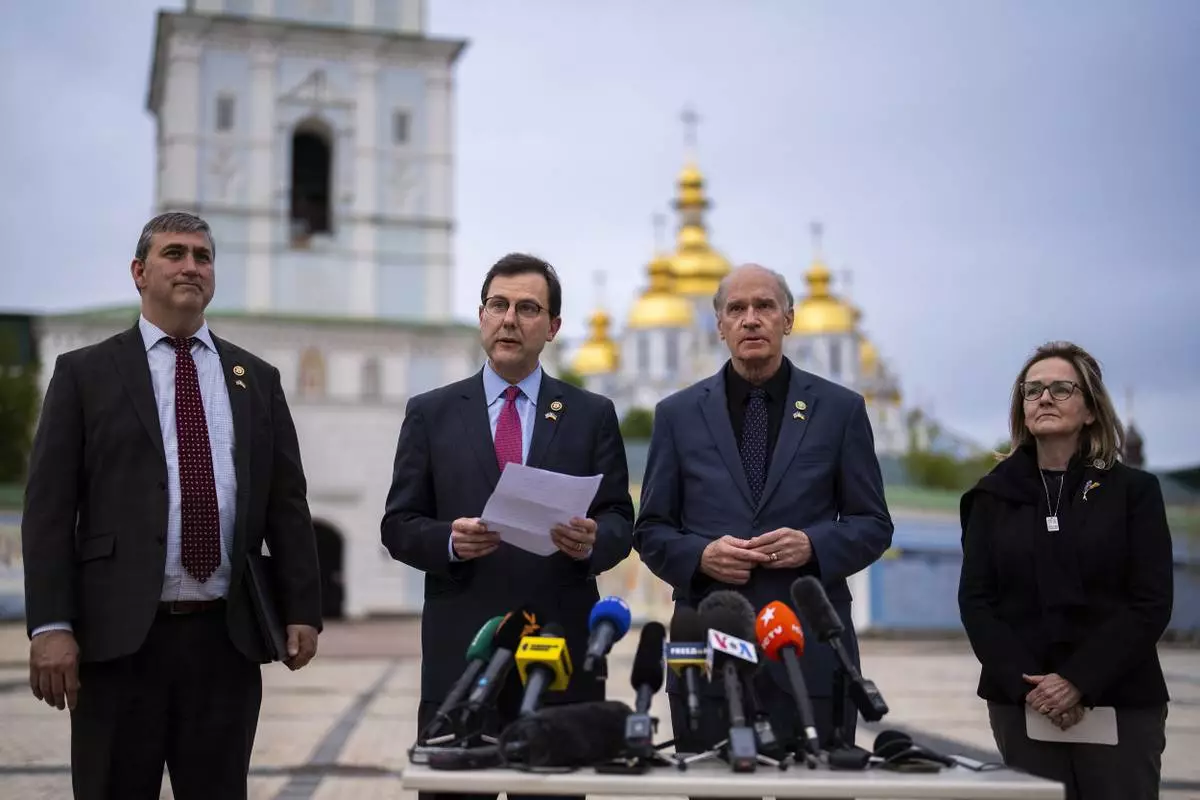
From left, U.S. representatives Nathaniel Moran, R-Tx, Tom Kean Jr, R-NJ, Bill Keating, D-Mass, and Madeleine Deane, D-Pa, talk to journalists during a joint news conference outside Saint Michael cathedral in Kyiv, Ukraine, Monday, April 22, 2024. A newly approved package of $61 billion in U.S. aid may prevent Ukraine from losing its war against Russia. But winning it will be a long slog. (AP Photo/Francisco Seco)
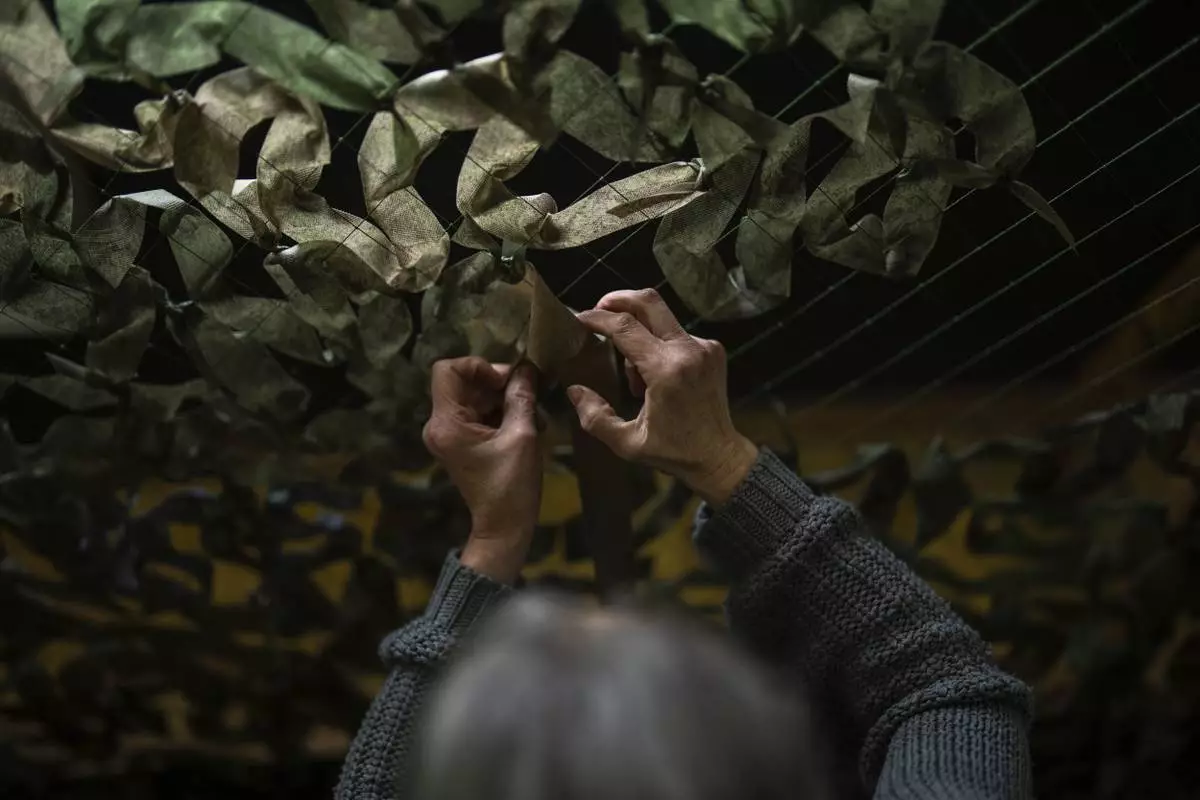
A volunteer makes a camouflage net at a facility producing material for Ukrainian soldiers in Kyiv, Ukraine, Monday, April 22, 2024. A newly approved package of $61 billion in U.S. aid may prevent Ukraine from losing its war against Russia. But winning it will be a long slog. (AP Photo/Francisco Seco)
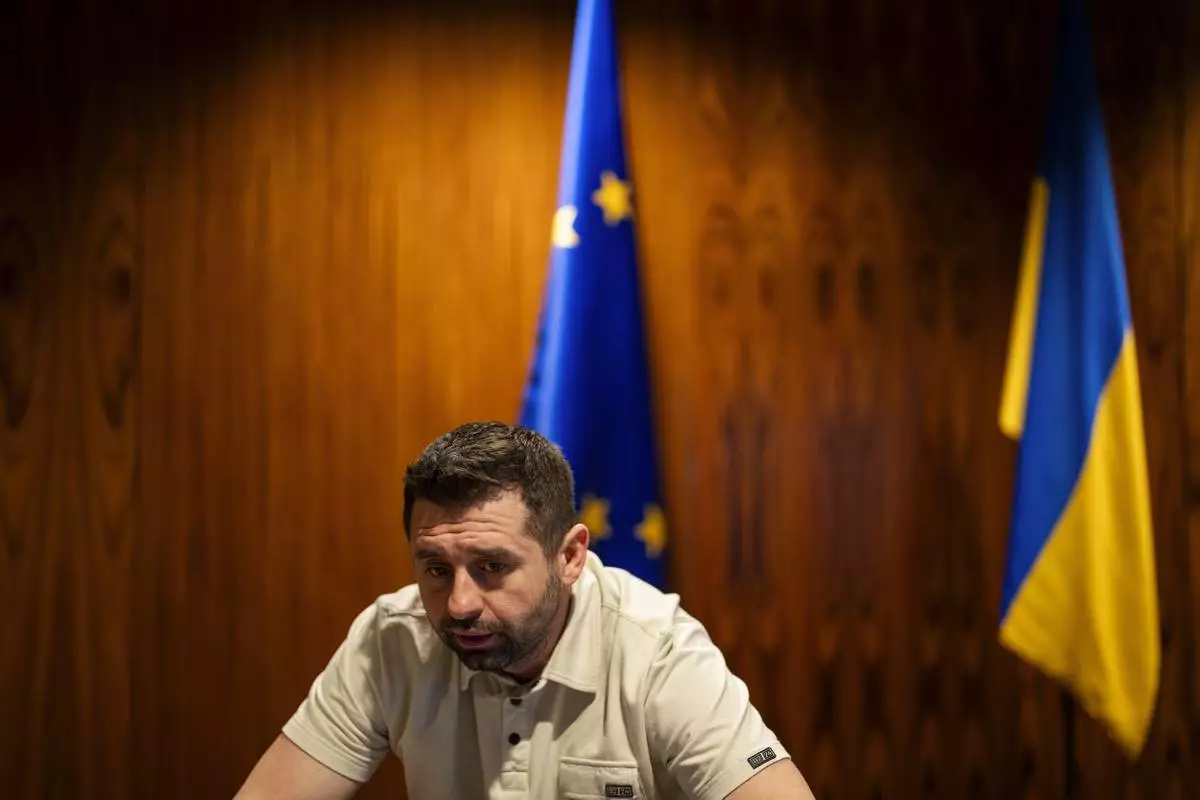
Davyd Arakhamia, a lawmaker with Ukrainian President Volodymyr Zelenskyy's Servant of the People party, talks during an interview with Associated Press in Kyiv, Ukraine, Monday, April 22, 2024. (AP Photo/Francisco Seco)
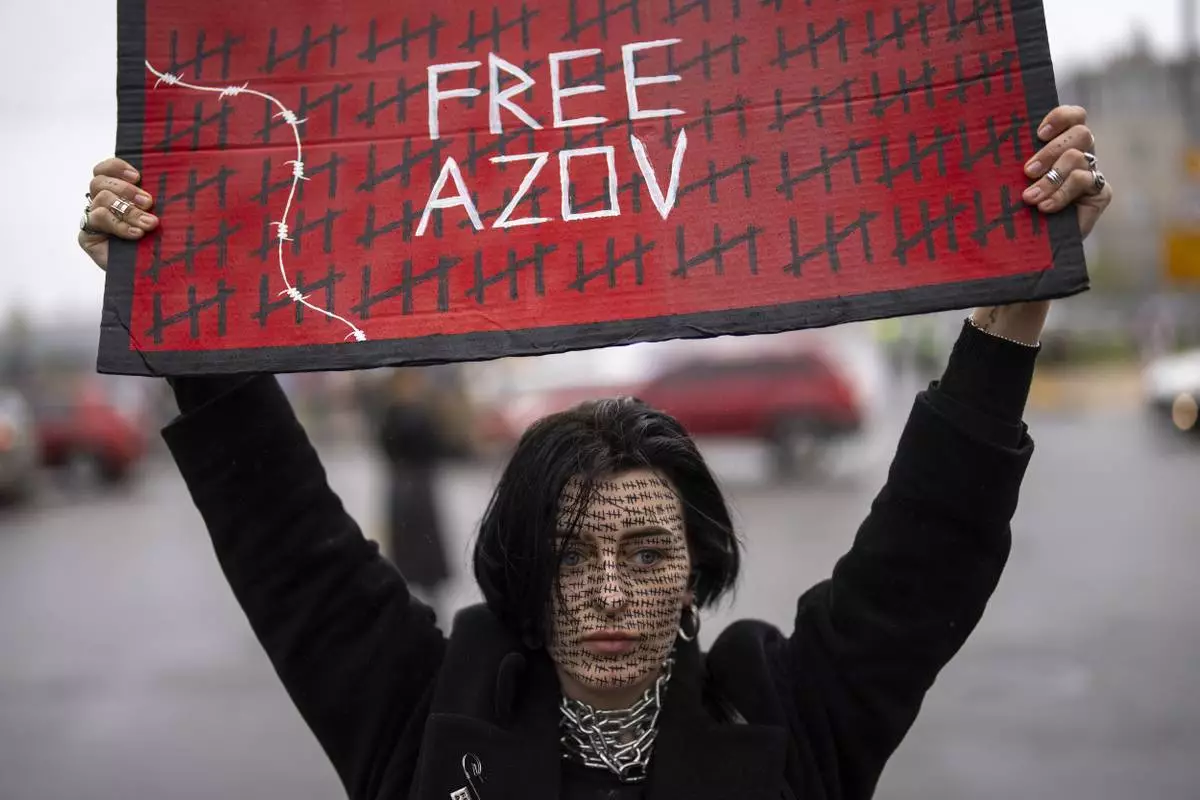
A woman rallies to raise awareness on the fate of Ukrainian prisoners of war in Kyiv, Ukraine, Sunday, April 21, 2024. (AP Photo/Francisco Seco)
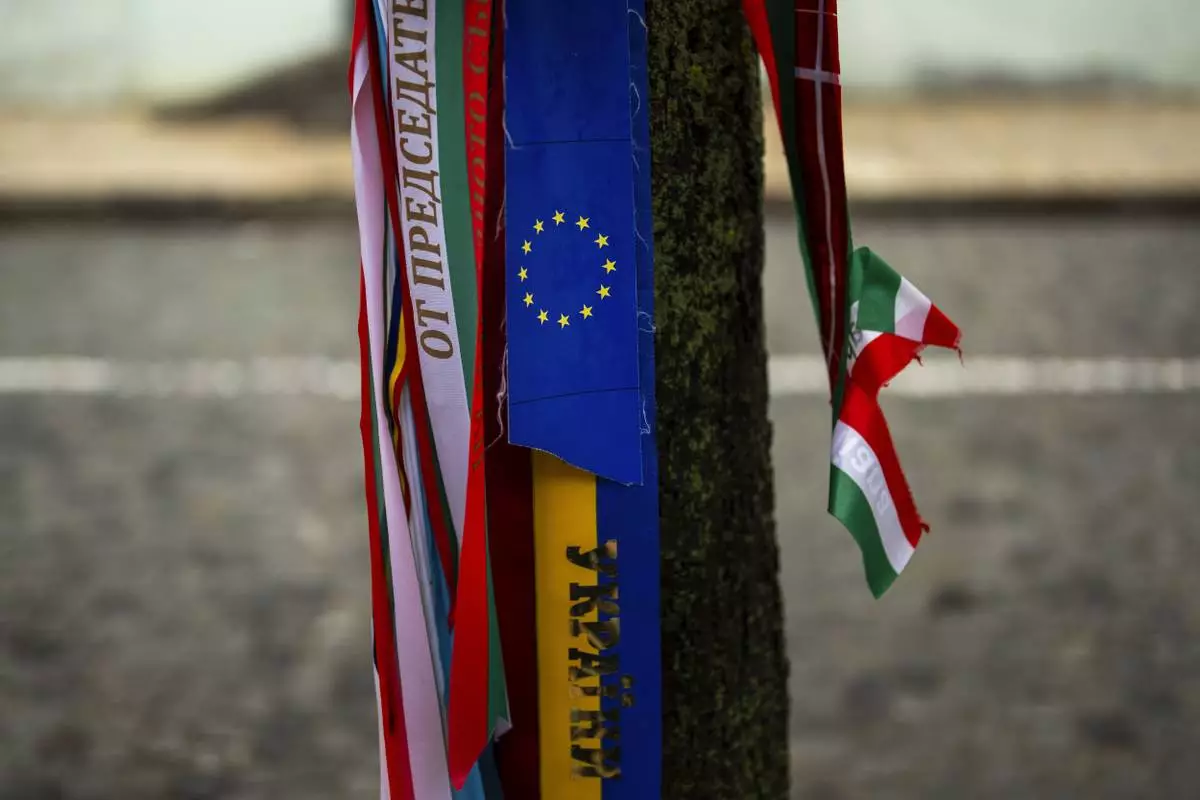
Ribbons with the colors of the European Union and Ukraine are attached to a tree next to memorial wall of Ukrainian soldiers killed during the war in Kyiv, Ukraine, Monday, April 22, 2024. (AP Photo/Francisco Seco)
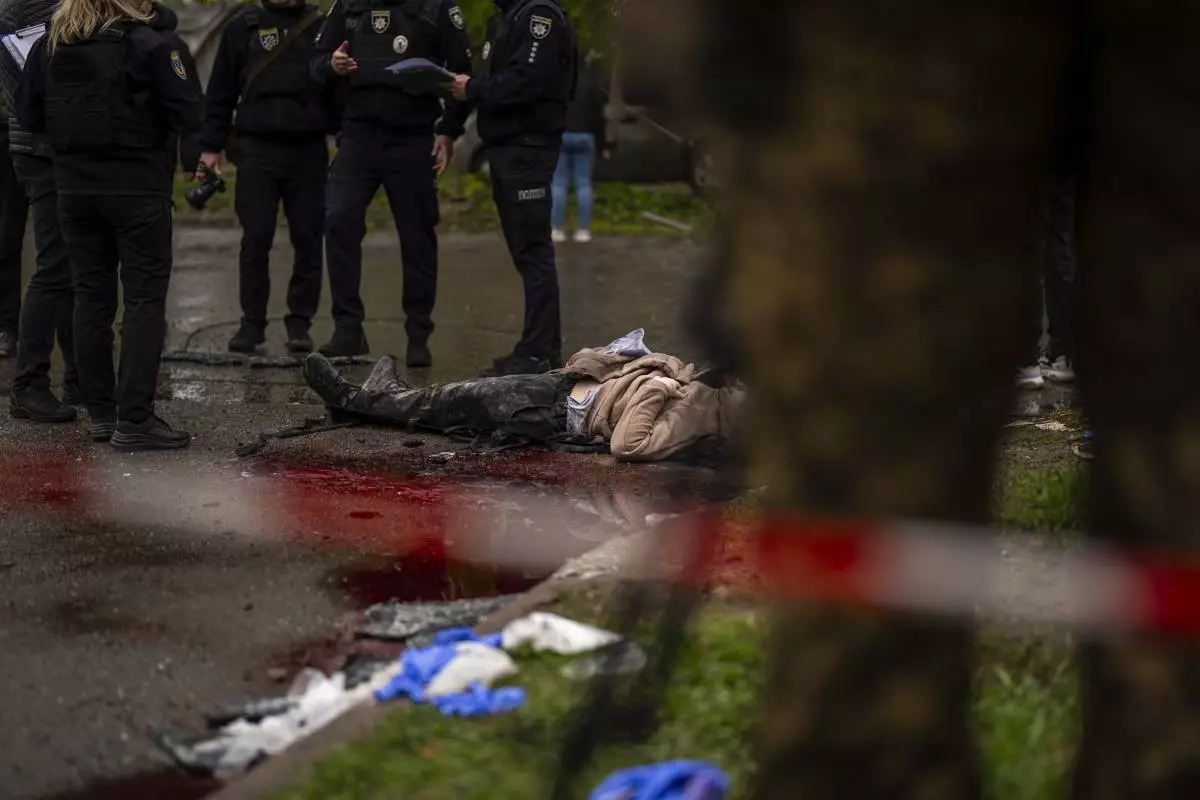
The body of a woman killed by Russian bombardment in Chernihiv, Ukraine, Wednesday, April 17, 2024. (AP Photo/Francisco Seco)

Soldiers carry the coffins of two Ukrainian army sergeants during their funeral in Lviv, Ukraine, Tuesday, April 16, 2024. (AP Photo/Francisco Seco)















